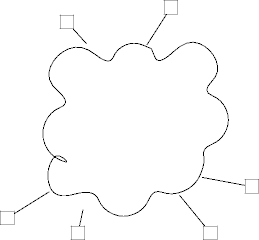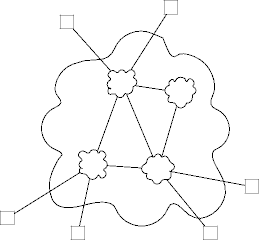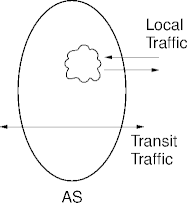Computer Networking Lecture Notes
2013 October 3 • Internetworking
Outline
- Function
- Hierarchy
- Architecture
- Piece parts.
- Integration
- Protocols
- Border gateway protocols.
Where Are We?
- How do we go from the left to the right?
- The Internet, how does it work?
|
|
|
Internetworking
- Internetworking combines independent networks into a common
network.
- An internetwork or internet.
- Note: an internet, the Internet.
Intenetworking Functions
- An internet should provide
- Uniform network services.
- Homogeneous behavior on heterogeneous systems.
- Transport-layer (at least) services.
- There is no middle of an internetwork.
- The independent networks maintain their separate identifies.
IP-Address Hierarchy
- IP addresses provide a simple, two-level hierarchy.

- Outside a network, only the network exists.
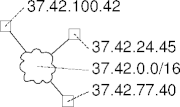
More Hierarchy
- IP (v4) addresses don't scale well to 100,000s of networks.
- Expensive to maintain and use.
- Large scale needs intermediate structure between networks and an
internet.

- Extra-technical motivations also intrude.
- Organizations and policies.
More Structure
- Networks group themselves into autonomous systems
(ASs, rfc 1930).
- An AS is also a (relatively) small internet.
- An AS is controlled by a single entity (a corporation, an agency, a government).
- Each AS has a 32-bit autonomous system number (ASN)
assigned by the Internet Assigned Number Authority
(IANA).
- Around 74,000 AS numbers have been allocated.
AS Traffic
- Local traffic is traffic into or out of an autonomous system.
- Transit traffic is traffic through an autonomous system.
|
|
|
AS Types
- A stub AS is singly-connected autonomous system.
- A multi-homed AS is a multiply-connected AS that doesn't carry transit traffic.
- A transit AS is a multi-homed AS that carries transit traffic.
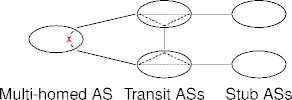
AS Hierarchy
- An internet of autonomous systems has (roughly) a three-level
structure.
1. Backbone
2. Service providers.
3. Customers - Backbone and provider levels are sets of peer ASs (roughly).
- Customers are individual ASs or smaller networks (roughly).
Recursion
- An autonomous system may contain smaller versions of itself.
- A non-AS group of networks may organize in an AS hierarchy.
- Example: dear old MU.
- Backbone: campus-wide ring.
- Provider: each building wired into the ring.
- Customers: each department wired into the building.
What About Scaling?
- IP addresses aggregate hosts as a network address.
- Autonomous systems aggregate networks as ASs.
- But AS numbers are not addresses.
- Each AS associates host addresses with ASs.
- Unaccessed networks can be ignored.
- Backbone ASs are still on the hook for everything.
Connecting
- What is a transport-layer connection?
- It is a path from one host through autonomous systems to the other
host.

- Finding that path is the routing problem.
AS Routing Policy
- An AS has a set of rules governing traffic through the AS.
- Multi-homed ASs have a no transit traffic rule.
- Microsoft won't route through Apple's AS, and vice versa.
- An AS's rule set is known as its routing policy.
- AS policies can get complicated quickly.
- And AS organizations tend to be competitive rather than cooperative.
AS Routing
- Routing through autonomous systems in an internet should
- Produce efficient and effective routes between hosts
- Respect the constituent ASs routing policies.
- Respecting policy takes precedence over effective routes.
AS Routing Protocols
- Autonomous systems use several routing protocols to route through an internet.
- The border gateway protocol (BGP, rfc 4271) is the main protocol used among ASs.
Border Routers
- A border router is a host in an autonomous system through which
traffic moves.
- Sometimes known as an edge router or a gateway.

- ASs are connected via border routers.
- An AS has at least one border router.
BGP Routers
- A BGP router is a host in an autonomous system that
communicates using BGP.
- Border routers are usually BGP routers, but don't have to be.
- An AS has to have at least one BGP router.
- BGP routers
- collect and distribute routing information with connected ASs.
- construct new routes based on collected routing information.
Internet Routes
- A path through an internet is a sequence of autonomous systems ending
at a network.
- For example: AS1, AS2, …, ASk, a.b.c.d/n.
- An AS's BGP routers maintain the path list.
- Potentially one path for every network.
- The BGP routers periodically advertise a subset of their path
list to connected ASs.
- The AS policy determines the list advertised.
Path Finding
- A BGP router determines new paths from path information advertised by
connected ASs.
- Add paths to previously unknown networks.
- Replace old paths with newer, better paths.
- Drop old paths that now violate policy.
- Internet path finding can be a difficult task.
- Local policies constrain and complicate choice.
- Connected ASs may advertise poor-quality information.
summary
- An internet combines many networks into a single network.
- This is a recursive definition.
- A tree-shaped hierarchy scales up to global-sized internets.
- For the most part.
- The constituent networks still maintain their autonomy.
- And that's what makes it interesting.
References
- The Global Internet (Section 4.1) in Computer Networking: A Systems Approach by Larry Peterson and Bruce Davie, Morgan-Kaufman, 2011.
- Internetworking (Section 5.5) in Computer Networks by Andrew Tanenbaum and David Wetherall, Prentice Hall, 2010.
| This page last modified on 2011 October 9. |
